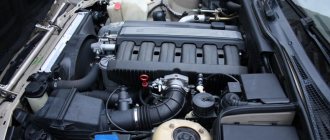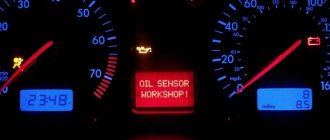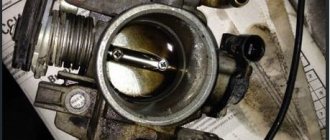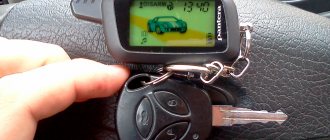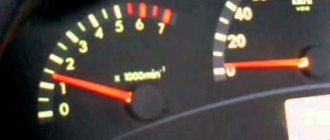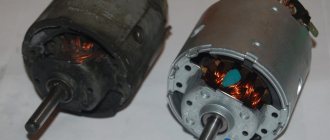If the steering wheel of a VAZ 2114 shakes when braking, this eloquently indicates the presence of vibration in the car. The reasons why this vibration occurs are very different. We will talk about some of them below. Steering wheel wobble indicates a problem in one or more mechanisms. And if the cause of this vibration is not found in a timely manner and it is not eliminated, then not only will the vibrating unit or part of the car wear out and fail. Vibration will also negatively affect other systems where it is felt.
Strong vibration when accelerating: reasons
Many car enthusiasts are familiar with the problem when vibration occurs when accelerating. There are many reasons for this phenomenon. Often, searching for a source can even drive a car enthusiast crazy. Let's look at the main reasons for shaking, because you really want the car to drive quietly and smoothly. In 75% of cases, the problem is detected and fixed, and the car owner can again feel calm and comfortable.
Manifestation of the problem
As a rule, if the car jerks, this is usually due to various circumstances. Every driver should understand that any non-standard situations do not appear out of nowhere; this may be due to a malfunction of a particular system. In turn, this is usually due to wear and tear on vehicle components. And if you lose sight of this, sooner or later, it can result in serious and costly repairs.
As for when the problem begins to manifest itself, vehicle jerking can be noticed in the following cases:
- Only when the car starts moving.
- When the engine is running at low speed.
- During a sharp increase in speed.
- When the car is moving at high crankshaft speeds.
- In any mode of vehicle movement, which is manifested by periodic jolts at different times.
But what exactly can cause a vehicle to behave this way? When a VAZ-2114 jerks while driving, there may be several reasons for this, and quite a few. In fact, this is what we will discuss further.
Steering wheel shakes when accelerating
Quite often, when driving, a strong vibration occurs on the steering wheel when accelerating. At first it is barely noticeable, but over time it becomes more noticeable. This can cause serious damage and lead to an accident.
The first thing you need to do is check the wheel balancing. To do this, you can go to the nearest tire repair shop. If your wheels are out of balance, then this is one of the popular reasons for shaking when accelerating. Fixing the problem won't cost much. Sometimes the disc becomes clogged with dirt or snow, then these beatings can occur and stop. It is very easy to determine the presence of dirt with alloy wheels, but with steel wheels, where the ventilation holes are small, it is difficult. Dirt collects inside the part.
Wrong wheel alignment
Wheel alignment is another important parameter that is set by adjusting the wheel position. Camber is the angle of the wheel relative to the vertical. The fact is that the wheels are installed on the car not strictly parallel to the vertical, but at a slight angle, which is not always noticeable to the average person. Toe-in, or toe-in, is the angle between the plane of rotation and the direction of movement of the car. Wheel alignment affects vehicle stability on the road, cornering, and the rate of tire wear. If this parameter is adjusted incorrectly, the steering wheel may wobble.
The need for balancing
Neither tires nor wheels are perfect in terms of geometry and composition. So, due to different masses in different parts of the wheel, those places where the weight is greater will pull the wheel axle towards themselves. At high speeds, the force will be transmitted to the rods, then to the steering wheel.
It is very important to perform balancing from time to time. Especially after changing tires or wheels. Using this procedure, you can equalize the masses of the wheels at each point. Driving a vehicle with unbalanced wheels can cause rapid wear on the chassis and suspension, a problem that is more difficult to correct.
Wheels
If, when the car reaches a certain speed, the steering wheel begins to shake, first of all you need to pay attention to the condition of the wheels and tires. A broken slope is a car tire that has become deformed due to an impact or falling into a hole and has a bump or other distortion on its surface.
And if at lower speeds such a problem manifests itself little, then with increasing speed, vibration also increases. It is almost impossible to eliminate the deformation of a tire; you can move the wheel on which such a tire is mounted back. Perhaps in this case the vibration will decrease, but the damaged ramp will have to be replaced, one way or another
A broken slope is a car tire that has become deformed due to an impact or falling into a hole and has a bump or other distortion on its surface. And if at lower speeds such a problem manifests itself little, then with increasing speed, vibration also increases. It is almost impossible to eliminate the deformation of a tire; you can move the wheel on which such a tire is mounted back. Perhaps in this case the vibration will decrease, but the damaged ramp will have to be replaced, one way or another.
Installing tires that do not match the surface can also cause the steering wheel to vibrate at speed. For example, if you install off-road tires, then on a normal highway, vibration may occur.
Misaligned side members, or other deformation of the car frame, can lead to incorrect wheel alignment angles. In this case, they say that the car is eating rubber. But in addition to rapid tire wear, vibration in the steering wheel may occur when a certain speed is reached.
Poorly tightened nuts that secure the wheels can easily cause the steering wheel to shake at high speed, and this is already very dangerous. Therefore, do not forget to check the condition of your wheels, as well as the reliability of their fastening.
Impaired wheel rim balancing is probably one of the most common causes of steering wheel vibration that occurs at speed. Balancing may be disrupted due to dirt adhering to some part of the wheel rim, due to a hole caught at speed, or other shock impacts on the wheel. In principle, it is possible to restore the imbalanced wheel rim, but it can no longer be called ideal. Except, of course, the case of dirt sticking. It just needs to be removed from the wheel.
Unreliable wheel mounts
This problem is also easy to fix and diagnose. This is a simple but very dangerous reason. The fastenings can be loosened even on one wheel, and this is enough to cause shaking. If the problem is not resolved in time, emergency situations may occur. If the wheel falls off while driving, the repair will be quite expensive - you will have to replace the disc and hub, and the brake disc.
The symptoms in this case are very similar to vibrations due to tires or bent wheels. But there is a cyclical pattern here, although not at all speeds.
Defective tires
This drawback occurs quite often, especially when car owners buy used tires rather than new ones. Visually hidden defects are difficult to detect; they do not make themselves felt immediately. Tires also become deformed during operation due to collisions with curbs, stones, and other irregularities. Bumps and breaks form on the tire, which are not always noticeable from the outside, but are very noticeable when driving. What to do with defective and damaged tires? Definitely change them. Less common is disc defects that can cause runout.
A wobbly steering wheel may be caused by one or more wheels being loose. A loose fastening can cause the bolts to come loose and the wheel to fall off. This situation is a dangerous emergency on the road. Therefore, if you feel vibration, do not be lazy, but take the key and check the bolts on the wheels. Body vibration and steering wheel beating are also affected by different tire pressures.
Checking the suspension and chassis
Vibration when accelerating can occur as a result of natural wear and tear on the struts or shock absorbers. The suspension stops working smoothly, which is one of the causes of the problem. This can be especially noticeable on rough roads or when driving at speed.
Another popular cause of shaking is the support bearing on the strut. This part can be found on top, above the shock absorber. It is also checked under the hood from the front. If you can find a worn bearing, you should replace it, and then the problem will be solved.
Ball joints in most cases wear out due to driving on poor quality roads. In our country, these parts need to be changed very often. If you find play in the supports, then perhaps by replacing it you will be able to regain your comfort.
Check and, if necessary, replace the tie rod ends. Over time, play appears in this mechanism due to wear. Thanks to this tip, the car's wheels can turn parallel. Worn tips cause shaking.
Crooked wheels
Although roads in big cities are getting better, this is not happening everywhere. And here and there we come across potholes, potholes and holes into which we drive with our wheels, thereby damaging either tires or wheels. And it happens that both of them happen, so much so that it is no longer possible to restore them. So, after such damage, strange vibrations appear, which can also manifest themselves both in the body and in the steering wheel. To determine this, it is necessary to remove the wheels and conduct a visual inspection of the rim for dents and deformations. But more accurately, this can be seen on a balancing machine in a tire shop, when the wheel rotates. There you can clearly see whether the disc is hitting or whether the tire itself is bent. Since the tire has a metal cord inside, with a strong impact it breaks and a lump or hernia appears on the wheel, as a result of which the rubber is deformed and becomes egg-shaped. This can be corrected in this way: replace the tire and roll the disc on a rolling machine.
Vibration when accelerating
This is terrible, especially when you need to accelerate quickly, for example if you need to overtake another car. Often when you press the pedal, acceleration is jerky and uneven. To make a correct diagnosis, you need to follow a few simple steps.
Check the oil level in the gearbox. Surprisingly, low transmission oil levels cause vibrations and shaking during acceleration. The car may also noticeably lose its dynamic characteristics. Jerking when pressing the accelerator pedal - this can also be a consequence of a lack of oil.
A dirty automatic transmission filter leads to various unpleasant effects. You can do the replacement yourself or use the services of specialists.
A worn driveshaft is a guaranteed noticeable vibration of the car when accelerating. The weak point here is the cross. Replace the part if necessary, otherwise it may cause more serious damage.
Also, such a nuisance can be caused by uneven engine operation. This often happens after renovations. Sometimes service station professionals simply forget to balance the crankshaft and flywheel. Another reason is an incorrectly configured carburetor.
Low oil level
If the steering wheel is difficult to turn, the reason may be a low fluid level in the power steering reservoir. This situation could arise for three reasons:
- The oil was not changed in a timely manner.
- Gradual wear of power steering elements.
- Damage to any element of the power steering on the road.
If the first situation occurs, you simply need to replace the fluid with a new one, filling the tank to the maximum mark.
If the second situation occurs and a slight leak of fluid is detected, then it is necessary to add fluid and inspect the system elements in the near future.
If the oil leakage is significant, since the hydraulic system has recently received serious damage, you cannot drive with power steering. Most power steering pumps in modern cars will suffer serious scuffing and damage if they continue to be used without oil.
In order to continue driving the vehicle, it is necessary to dismantle the drive belt of the power steering pump or call a tow truck.
Engine mounts, gearbox mounts and other reasons
This is another possible group of reasons why a car may shake when accelerating. All these problems can arise for various reasons. For example, as a result of examinations, a breakdown of one of the power unit airbags is discovered. It's easy to find out - increase the engine speed when vibrations appear.
Body vibration when accelerating from 80 km/h to 100 km/h can also occur if there is a problem with the gearbox. Testing this hypothesis is very simple. It is recommended to reach a speed of about 85 km/h, then depress the clutch pedal and watch how the car behaves. Engage third gear and release the clutch. Accelerate from 50 km in the last gear of the transmission.
If the nature of the beats does not change during all these events, the gearbox is not to blame. If the vibration level increases when the box is connected to work, then you can check its involvement.
This method is suitable for both manual transmissions and automatic transmissions. In the case of an automatic transmission, at speeds of approximately 90 km/h, turn on 3.2, D, N on the gearbox, and then monitor the operation of the automatic transmission and the car. Watch the vibrations. Most often, the fault of the box in beating is minimal, but practice shows that there is such a possibility.
Electronics problems
If after checking it turns out that the ignition system is fully operational, you should pay attention to the on-board electronics, and first of all, to the electronic control unit. If it fails, it will not be possible to repair it, since it is not a repairable device
Ignition module VAZ 2114
But, in some cases, flashing it ER19 can help, after which fuel consumption is normalized, and vibration in the body of the VAZ 2114 completely disappears.
If the ECU is working properly, then you should check the idle speed sensor.
To do this you will need:
- Remove the sensor.
- Disconnect the terminals from it.
- Turn the multimeter into ohmmeter mode with a range of up to 200 Ohms and attach its probes to the sensor contacts.
If the latter is working properly, then the resistance will be in the range from 50 to 80 Ohms. Otherwise, the sensor should be replaced with a new one of the same model. Checking the idle speed sensor VAZ 2114
The next step in troubleshooting is to check the mass air flow sensor.
It is performed according to the following scheme:
- Disconnect the terminals from the sensor contacts, and then connect the multimeter probes to the latter.
- Set the tester to voltmeter mode with a range of up to 2 volts.
- Take voltage measurements with the engine running and off.
If the sensor is working properly, in both cases it should be in the range from 0.9 to 1 volt. Checking the air flow sensor of the VAZ 2114
If the air flow sensor also turns out to be working, then the problem should be looked for in the EGR sensor, which is responsible for exhaust gas recovery. This device, which has a conical shape, does not need to be checked with a multimeter - it is enough to blow it with any spray to clean the injectors or carburetor (by the way, such cleaning should be done periodically, regardless of the correctness of the current operation of this sensor).
What else should you pay attention to?
Vibration when accelerating can be felt due to unreliable mounting of the engine and exhaust system parts. It is better to perform this check with the engine running and then turned off. There are also cases when shaking is caused by a damaged radiator fan.
Next, check the attachment. Often the problem can be solved by replacing the drive belts or balancing the pulley. It would be a good idea to check the clutch basket and flywheel. You can do this as follows. Depress the clutch and place the selector in first gear. Next, start the engine and wait a couple of seconds. Then the lever is moved to the neutral position and the foot is removed from the pedal. Are there still vibrations? Look for the problem in the flywheel and clutch basket.
Vibration in the body and deformed rims
Often the cause of unpleasant vibrations is disc deformation. This is easily determined on balancing stands. Most often, deformations occur due to driving through potholes. The problem occurs in the spring, when their numbers increase.
If it is not possible to go to the stand, then you can try to find the dent visually. Most severely, the disc jams from the inside. Stamped steel wheels are more likely to deform than their cast counterparts.
In addition to dents, vibration at speeds of 100-120 km/h can also be caused by simply a curved disk. At the same time, the wheel can rotate smoothly on the stand. This is because it is attached to the device through the central hole. On a car, the wheel is not centered when installed. Warped discs also come from the factory.
Let's sum it up
So, common causes include wheel mounts, loose brake discs, a deformed drive shaft, constant velocity joints, and wheel bearings.
Vibration occurs when accelerating from anything. There are a lot of reasons. But if you try, you can detect them yourself and not pay for diagnostic services at a service station. But if suddenly you can’t figure it out on your own, don’t put off the decision. This leads to bad consequences. With simple steps, you will definitely find the causes of vibrations in your car and eliminate them. Take malfunctions seriously, because a neglected problem can cause an accident.
Didn't find the information you are looking for? on our forum.
Features of the internal combustion engine
Any four-cylinder, four-stroke engine is unbalanced. It would seem: two pistons go down, two go up, everything is balanced. But second-order inertial forces remain uncompensated, which try to shake the entire engine up and down with a frequency twice the crankshaft speed. To combat this phenomenon, a scheme was invented with two balancing shafts rotating in opposite directions twice as fast as the crankshaft. These shafts, with their vibrations, make it possible to completely compensate for vibrations caused by the imbalance of the connecting rod and piston group. An example would be the Nissan MR20DE engine, which is found on our popular X-Trail and Qashqai crossovers.
The balancer shafts are strictly synchronized with each other by gears, and the drive from the crankshaft is carried out by a chain.
The balancer shafts are strictly synchronized with each other by gears, and the drive from the crankshaft is carried out by a chain.
Why don’t VAZ motorists use this solution? The fact is that such systems are installed on engines with a displacement of 2 liters or more. For such a motor, the mass of the piston and connecting rod assembly turns out to be quite large. If the working volume is smaller, then the piston diameter and connecting rod length are also smaller - as is the total weight of the parts. As a result, there are fewer vibrations. The largest mass-produced engine in Togliatti has a displacement of 1.8 liters. Therefore, there are no balancing shafts here.
